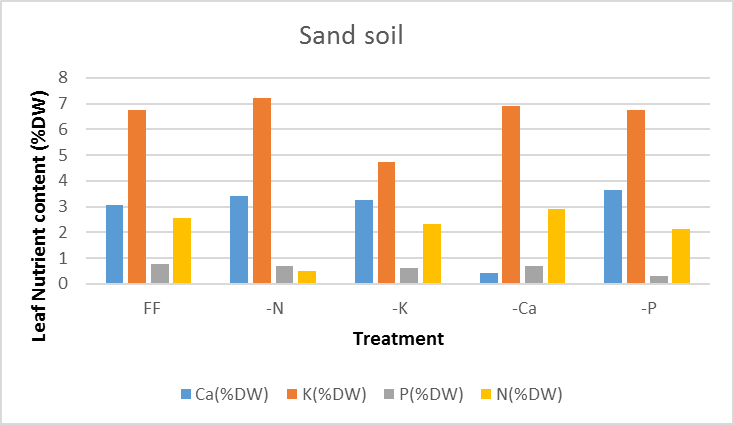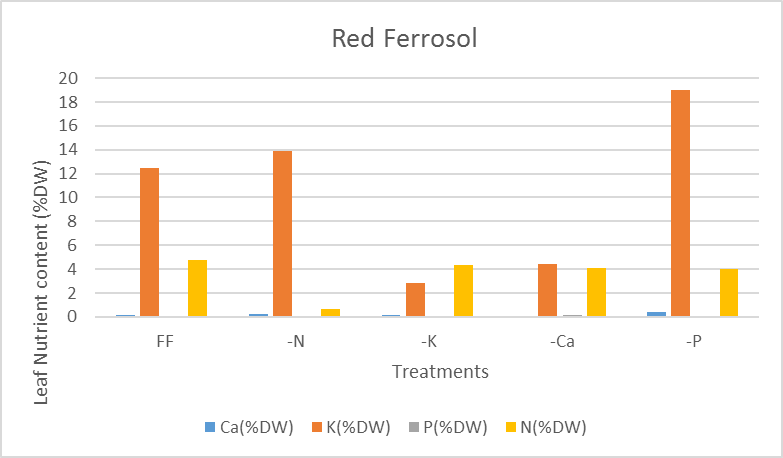Abstract
Plants regularly require a variety of minerals and nutrients that are available in the soil for healthy growth and development. Any form of deficiency in one of the required elements often comes with a deterioration of the plant’s general condition. In this lab experiment, tomatoes were nurtured in diverse deficiency mediums and closely observed throughout a month. The deficiency effects of phosphorus, potassium, nitrogen, as well as calcium, were closely observed and the weight of the plant and other parameters were carefully computed and observed. All the various treatments directly affected the development of the tomatoes.
Introduction
Plants require a certain amount of micronutrients such as phosphorus, carbon, calcium, and nitrogen together with trace levels of micronutrients like ion in their medium to record the required development. Plant tissue and natural soils are significantly complex and contain more than six elements, close to 19 of which are crucial for growth purposes. Any forms of deficiencies when it comes to these minerals lead to several deteriorating effects on plants that include chlorosis, drying of the leaves, and even necrotic spotting. If these symptoms become visible on older leaves first, the minerals in question are thus known as a mobile element (Martaet al. 2014).
In this experiment, the minerals phosphorus and nitrogen are regarded as mobile elements. An immobile element, like iron, has the effect of localizing the damaging effects on the plant’s younger leaves and terminal growth. Nitrogen deficiency in plants may lead to stunted growth as well as drying and yellowing of some leaves (Mengel et al. 2007). This work aims to find out the effects of various kinds of minerals on plant growth and health and how their deficiency would affect the health of the plants.
The experiment is supposed to teach us about the symptoms of specific nutrient-deficiencies such as lack of calcium, iron, potassium, as well as phosphorus. The available literature has covered most of these deficiencies but the question on the effect of different soil types is yet to be fully explored. The experiment will examine the effects of different soil.
Results and Discussion
The expected stunting of growth and chlorosis leads one to hypothesize that there would be a marked difference in plant weight as well as Standard Chlorophyll Level when it comes to drawing a comparison between the positive and negative controls. The null hypothesis is that the observable values are similar for both kinds of treatment. The following was the collected data.


Discussion
A comparison of the plant characteristics of two sets of plants undergoing the same treatment in both sand and red ferrosols illustrated some notable differences. The plants were placed I the sand soil were comparatively weaker than those placed in the red ferrosol soils. This could be explained by the fact that sand soil leaches out nutrients at a quicker rate than red ferrosol soil.
This meant that even with the same nutrient quantity being placed in both soil samples, the plants that were placed in sand soil ended up with fewer nutrients since the same are leached out at a faster rate. The plants that were planted in the Sand Soil with similar nutrient deficiency to the Red ferrosol were on average 4.4 grams or 20% lighter than those planted in the Red Ferrosol soils.
However, the plants still reacted differently when treated differently in the same soil types. This was mainly because the withdrawal of certain nutrients deprives the plant of vital nutrients that are needed for development and growth. The plants that had been placed in the distilled medium recorded the slowest growth and size-wise, were only one-third of the plants that had been placed in the complete medium. Symptoms associated with any forms of deficiency were initially visible 21 days into the experiment. The phosphorus-deficient plants appeared quite thin but were still towering over the plants that had been placed in the complete setup. Nitrogen-deficient plants began showing visible symptoms of chlorosis (George, Hall & Klerk 2007).
The average plant weight notably decreased in all the nutrient-deficient treatments compared to the complete control treatment. The results were expected since as already discussed, any form of mineral deficiencies leads to stunting effects amongst plants and in this case Tomato plants.
Nitrogen, Phosphorus, as well as Potassium are all mobile plant nutrients This explains the reason when they leaves were eventually tested from the various soil types, their overall amount was particularly low in the respective plant leaves (George, Hall & Klerk 2007). Plant nutrient mobilization is mainly characterized by three mechanisms namely contact (soil/root), diffusion, and finally mass flow (George, Hall & Klerk 2007). The availability of any of the mentioned nutrients is dependent on the relative solute concentration, the pH of the affected soil, the presence or absence of any precipitating elements, and the relative soil moisture (George, Hall & Klerk 2007).
Calcium can also be classified as a precipitating element when it comes to planting nutrient uptake (George, Hall & Klerk 2007). This is notable in the two tables above. The samples that were nutrient deficient had other nutrient uptake statistics that significantly deviated from similar nutrient uptake in the fully-fertilized samples (George, Hall & Klerk 2007). For example, in red ferrosols, the soil samples that were calcium-deficient deviated by close to 70% when it came to comparing them with other samples that had other nutrients missing. The FF sample had a K soil presence of 12.5, however, in the sample that had Ca absent, the leaves recorded a figure of 4.4 which represented a deviation of over 8.1.
The tomato plants that were placed in the calcium-deficient medium had observable localized tissue necrosis that led to stunted development. Some of the plants had notable curling of their leaves and root tips. The plants that developed fruits developed blossom end rot with the fruits showing signs of decay at their blossom end (Alloway 2008). Calcium is a primary component of cells. It holds the cell’s walls and stabilizes the cellular membranes. The mineral also plays a direct role in balancing salt levels within plant cells. It also activates the potassium to be able to regulate the closing and opening of the stomata thus allowing water movement (Welbaum 2015).
The plants in the potassium-deficient medium developed dark green dots near their leaf margins. The stems turned out woody and growth slowed down. Since potassium is a mobile element in plants, it moved to the younger leaves when supply was detected as falling short(Steward 2006). However, even though the growth of the deficient plants may not be significantly impaired, the quality and yield of the fruit are usually significantly affected, and the crops become prone to wilting(Russo 2012).
It is worth noting that after the lapsing of five weeks, a majority of the plants that were present in the complete treatment had fallen over completely(Ashman & Puri 2013). The tomato roots had ended up clogging the system thus inhibiting growth since the plants had simply become too big.
This may, however, have been prevented in case the experiment had been launched with the use of younger smaller plants. Staring out with younger tomatoes would have also allowed the deficiency symptoms to be more visible. Additionally, since the plants had been sectioned in different areas of the room based on the kind of treatment, errors may have developed in case there were defects regarding lighting. A more random mode of planting would have eliminated the errors. The observable physiological defects due to the absence of crucial nutrients in the plants are well documented.
Conclusion
Both macro and micronutrients play a crucial role in plant growth and development. The experiment illustrated the fact that potassium stimulates growth and improved the plant’s efficiency in the use of water. A healthy tomato plant requires the presence of all these minerals in its soils/growth medium to improve its harvest and longevity. The biomass between plants grown in nutrient-deficient medium and the ones in the control experiment was different.
List of References
Alloway, B J 2008, Micronutrient deficiencies in global crop production Springer, Dordrecht, Netherlands.
Ashman, M, & Puri, G 2013, Essential soil science a clear and concise introduction to soil science, John Wiley & Sons, New York.
Chesworth, W (ed.)2008, Encyclopedia of soil science, Springer,Dordrecht, Netherlands.
George, E F, Hall, M. A, & Klerk, GJ D 2007, Plant propagation by tissue culture. Vol. 1, Vol. 1.Springer, Dordrecht, Netherlands.
Horst, W J 2006, Plant nutrition: food security and sustainability of agro ecosystems through basic and applied research, Kluwer Academic Publishers,Dordrecht, Netherlands.
Marta, W V, Lorraine E. W, Felipe K R, Raul A S& Paloma K M 2014, From soil to seed: micronutrient movement into and within the plant, Frontiers Media Sa, Lausane, Switzerland.
Mengel, K, Kirkby, EA, Kosegrten, H, & Appel, T 2001, Principles of plant nutrition, kluwer academic publishers, Dordrecht, Netherlands.
Russo, V M 2012, Peppers: botany, production and uses,Wallingford, Oxfordshire.
Steward, F. C 2006, Plant physiology. Volume 3, Volume 3.Academic Press, New York.
Welbaum, G. E 2015, Vegetable production and practices, Cabi, Boston.